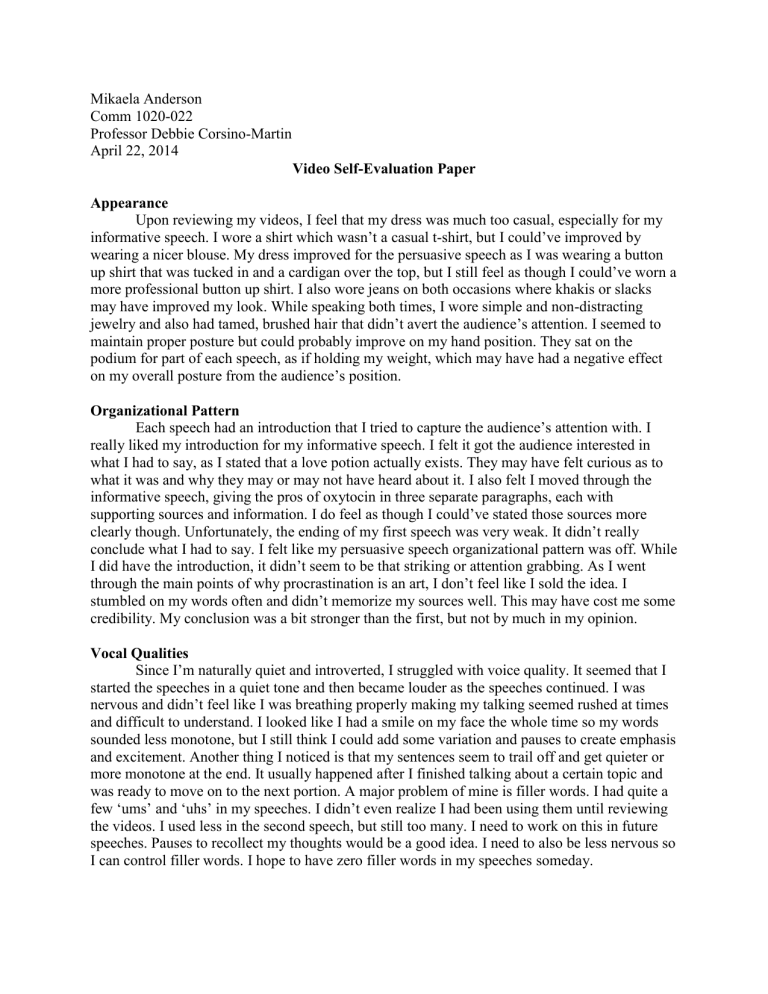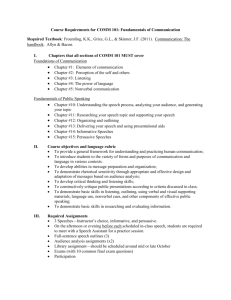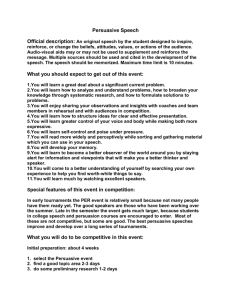File

Mikaela Anderson
Comm 1020-022
Professor Debbie Corsino-Martin
April 22, 2014
Video Self-Evaluation Paper
Appearance
Upon reviewing my videos, I feel that my dress was much too casual, especially for my informative speech. I wore a shirt which wasn’t a casual t-shirt, but I could’ve improved by wearing a nicer blouse. My dress improved for the persuasive speech as I was wearing a button up shirt that was tucked in and a cardigan over the top, but I still feel as though I could’ve worn a more professional button up shirt. I also wore jeans on both occasions where khakis or slacks may have improved my look. While speaking both times, I wore simple and non-distracting jewelry and also had tamed, brushed hair that didn’t avert the audience’s attention. I seemed to maintain proper posture but could probably improve on my hand position. They sat on the podium for part of each speech, as if holding my weight, which may have had a negative effect on my overall posture from the audience’s position.
Organizational Pattern
Each speech had an introduction that I tried to capture the audience’s attention with. I really liked my introduction for my informative speech. I felt it got the audience interested in what I had to say, as I stated that a love potion actually exists. They may have felt curious as to what it was and why they may or may not have heard about it. I also felt I moved through the informative speech, giving the pros of oxytocin in three separate paragraphs, each with supporting sources and information. I do feel as though I could’ve stated those sources more clearly though. Unfortunately, the ending of my first speech was very weak. It didn’t really conclude what I had to say. I felt like my persuasive speech organizational pattern was off. While
I did have the introduction, it didn’t seem to be that striking or attention grabbing. As I went through the main points of why procrastination is an art, I don’t feel like I sold the idea. I stumbled on my words often and didn’t memorize my sources well. This may have cost me some credibility. My conclusion was a bit stronger than the first, but not by much in my opinion.
Vocal Qualities
Since I’m naturally quiet and introverted, I struggled with voice quality. It seemed that I started the speeches in a quiet tone and then became louder as the speeches continued. I was nervous and didn’t feel like I was breathing properly making my talking seemed rushed at times and difficult to understand. I looked like I had a smile on my face the whole time so my words sounded less monotone, but I still think I could add some variation and pauses to create emphasis and excitement. Another thing I noticed is that my sentences seem to trail off and get quieter or more monotone at the end. It usually happened after I finished talking about a certain topic and was ready to move on to the next portion. A major problem of mine is filler words. I had quite a few ‘ums’ and ‘uhs’ in my speeches. I didn’t even realize I had been using them until reviewing the videos. I used less in the second speech, but still too many. I need to work on this in future speeches. Pauses to recollect my thoughts would be a good idea. I need to also be less nervous so
I can control filler words. I hope to have zero filler words in my speeches someday.
Delivery
Upon starting the class, I was really nervous and stiff when I gave speeches. By the time I reached my informative and persuasive speeches, I had improved a lot. I made a lot of hand gestures to be less stiff, but almost too many it seems. My hands were constantly moving while I spoke and most of the time, they weren’t purposeful gestures. Occasionally I would count with my figures as I read off a list and sometimes would move them as I talked about order of things.
At some points, I pointed at my paper on the desk to help me remember my spot and I think that looks really bad as I view it like an audience member. I definitely need to control my movement and perhaps move my body instead. Also, I need to remember not to make adjustments of clothing or my glasses that tend to slip down. It looks unprofessional. In conversational situations I am quite good at making eye contact, but when giving speeches, I need to do that more often. I was always looking at my papers for help. When I did look out to the audience, I did not roam as much as I should have. I tended to look near the center of the classroom.
Improving this may allow me to connect with the audience better.
Visual Aid
I like the overall look of my first visual aid. The colors were nice on the slide, the pictures were simple, and there were no words to distract. I wish I would have found another type of visual aid for the informative speech besides the PowerPoint slide. I believe I would have connected with the audience better if I had used a physical item in the slide’s place. I didn’t connect my speech to the visual aid at all, really. I rushed it in at the end and I think the audience would’ve benefitted from knowing what each picture had to do with my topic. For my persuasive speech, I liked the color scheme and simplicity of my PowerPoint presentation. It was easy to read, the titles were big and simple. I also went over what was on my visual aid much better than my first speech. Perhaps I could’ve added more important and relevant things in the persuasive
PowerPoint. I did well as far as opening and controlling my visual aid. I was prepared and knew how to use the computer.
Audience Connection
Pathos: I think the audience connected to my topic when I told them how applicable oxytocin was to everyday life. Every person had undoubtedly been in at least one situation and they could then use that situation to relate and think about the importance of the topic. Also, using a little anecdote about wishing life had a real love potion may have helped the viewers connect as well because they may have seen something or even wished themselves that the potion was real, making the topic incredible relatable.
Logos: Using credible sources to back up my information may have appealed to logos. When the audience considered one of the examples that I presented, they would’ve been able to identify with it, confirming its truth and then using the sources as a confirmation. The real life occurrence would then seem logical to the audience.
Ethos: My background in human physiology and biology, and my school major gave me credibility to speak about the topic of oxytocin. Also, I did a lot of research and even spoke to a doctor of physiology about the topic, which contributed to that credibility as well. As a selfproclaimed chronic procrastinator, I have learned that the pressure does tend to improve my work, as I have also studied ahead of time and didn’t perform as well. This could be a source of credibility for my persuasive topic.
Strengths
My strengths included being knowledgeable and passionate about each topic and with providing relatable examples. I also was able to hide my nervousness quite well and it was difficult for the audience to tell that I doubted my abilities at all. Being knowledgeable about the topic allowed for me to get the message across pretty well and it helped the audience feel like I was giving credible information. When I first started this course, I was nervous and very monotone and quite stiff. I also “forgot to breathe” which made my delivery worse. When I did these two presentations, I used more hand gestures and movement to hide my nervousness about public speaking. I was even told by one classmate as I returned to my seat that I “didn’t even look nervous at all!” I feel accomplished that I could channel my nervousness into the presentation in a positive way.
Areas to Improve
Since this course is so short, I of course still have many areas to improve. I must learn to cut out filler words so I appear more knowledgeable, less nervous, and more organized. I need to improve my voice quality as well. I talk quietly in general and I need to learn to stay at a consistent pace, speak loud and clear, and annunciate all my words properly. Most importantly, I need to stop reading from my paper. I ought to try not procrastinating so I have more time to memorize the information, whether that helps or not, it’s worth a shot. Eye contact is very important as far as connecting with the audience and letting them know you actually know what you’re talking about. I know I really enjoyed the presentations of classmates that hardly looked at their paper or didn’t look at all. The presentations were intriguing, fun, and thought provoking as you could see they knew their stuff and were very knowledgeable. I’d like to be able to do that at some point in my life while speaking in public.



